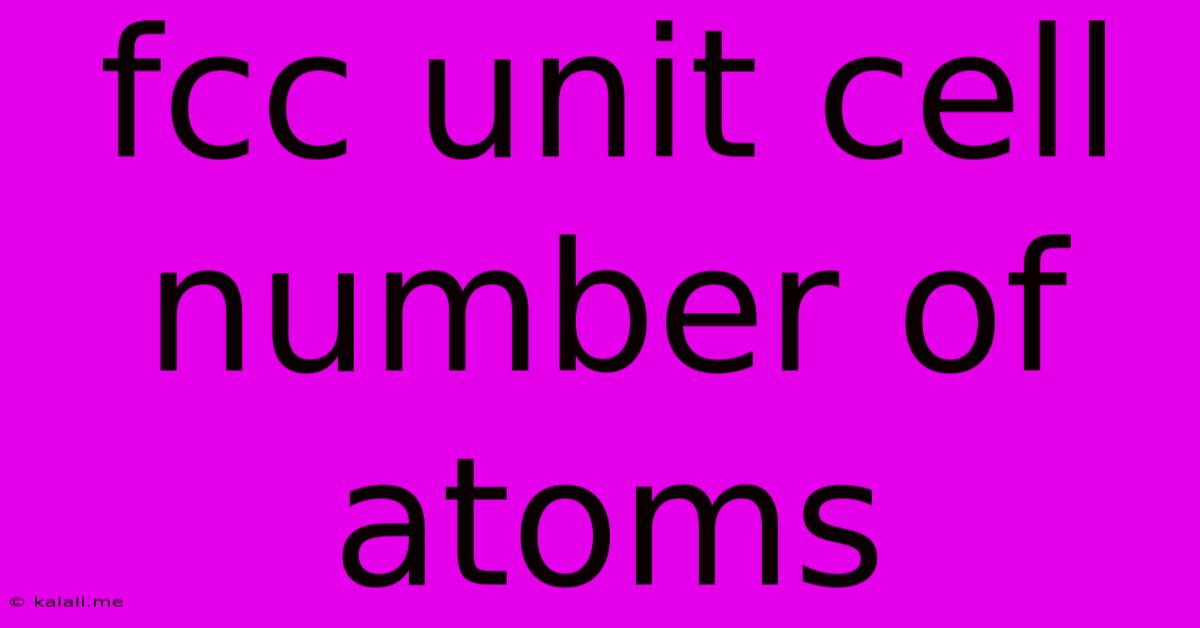Fcc Unit Cell Number Of Atoms
Kalali
Jun 15, 2025 · 2 min read

Table of Contents
Determining the Number of Atoms in an FCC Unit Cell
The face-centered cubic (FCC) unit cell is a common crystal structure found in many metals, including aluminum, copper, and gold. Understanding how to calculate the number of atoms within this unit cell is crucial for various material science applications, from determining density to understanding material properties. This article will guide you through the process, explaining the concepts clearly and concisely.
What is a Unit Cell?
A unit cell is the smallest repeating unit of a crystal lattice. Think of it as the building block that, when repeated in three dimensions, creates the entire crystal structure. Different crystal structures have different unit cell arrangements, influencing their properties. The FCC structure is characterized by atoms located at each of the eight corners and at the center of each of the six faces of the cube.
Calculating the Number of Atoms in an FCC Unit Cell:
To determine the number of atoms in an FCC unit cell, we need to consider the contribution of atoms at different positions within the unit cell:
-
Corner Atoms: Each of the eight corner atoms is shared by eight adjacent unit cells. Therefore, each corner atom contributes only 1/8 of an atom to the unit cell. The total contribution from corner atoms is (1/8 atom/corner) * 8 corners = 1 atom.
-
Face-Centered Atoms: Each of the six face-centered atoms is shared by two adjacent unit cells. Thus, each face-centered atom contributes 1/2 of an atom to the unit cell. The total contribution from face-centered atoms is (1/2 atom/face) * 6 faces = 3 atoms.
Total Number of Atoms:
Adding the contributions from corner and face-centered atoms, we get the total number of atoms within a single FCC unit cell: 1 atom (from corners) + 3 atoms (from faces) = 4 atoms.
Therefore, an FCC unit cell contains a total of four atoms. This is a fundamental characteristic of the FCC crystal structure.
Practical Applications and Further Considerations:
Understanding the number of atoms in an FCC unit cell is essential for calculating:
-
Atomic Packing Factor (APF): The APF represents the fraction of volume in a unit cell that is occupied by atoms. Knowing the number of atoms allows for accurate APF calculation.
-
Density: The density of a material is directly related to the number of atoms in the unit cell, the atomic weight, and the unit cell dimensions.
-
Diffraction Patterns: The arrangement of atoms in the FCC unit cell influences the diffraction patterns observed in techniques like X-ray diffraction, providing information about crystal structure and orientation.
This knowledge is fundamental in various fields, including materials science, metallurgy, and solid-state physics. Further exploration into crystallography and solid-state chemistry can provide deeper insights into the behavior and properties of materials with FCC structures. Remember that this calculation is applicable only to ideal FCC structures; real-world materials may exhibit imperfections and deviations.
Latest Posts
Latest Posts
-
Which Of The Following Sentences Are Correct
Jun 16, 2025
-
What Are The Differences Between Representative Democracy And Direct Democracy
Jun 16, 2025
-
Admission Requirements For Tarleton State University
Jun 16, 2025
-
What Is The Factor Of 86
Jun 16, 2025
-
What Are Blocks In Periodic Table
Jun 16, 2025
Related Post
Thank you for visiting our website which covers about Fcc Unit Cell Number Of Atoms . We hope the information provided has been useful to you. Feel free to contact us if you have any questions or need further assistance. See you next time and don't miss to bookmark.